Papers by Michael Hurwitz

JNCI Cancer Spectrum, May 2, 2023
Disparities in metastatic renal cell carcinoma (mRCC) outcomes persist in the era of oral antican... more Disparities in metastatic renal cell carcinoma (mRCC) outcomes persist in the era of oral anticancer agents (OAAs) and immunotherapies (IOs). We examined variation in the utilization of mRCC systemic therapies among US Medicare beneficiaries from 2015 to 2019. Logistic regression models evaluated the association between therapy receipt and demographic covariates including patient race, ethnicity, and sex. In total, 15 407 patients met study criteria. After multivariable adjustment, non-Hispanic Black race and ethnicity was associated with reduced IO (adjusted relative risk ratio [aRRR] ¼ 0.76, 95% confidence interval [CI] ¼ 0.61 to 0.95; P ¼ .015) and OAA receipt (aRRR ¼ 0.76, 95% CI ¼ 0.64 to 0.90; P ¼ .002) compared with non-Hispanic White race and ethnicity. Female sex was associated with reduced IO (aRRR ¼ 0.73, 95% CI ¼ 0.66 to 0.81; P < .001) and OAA receipt (aRRR ¼ 0.74, 95% CI ¼ 0.68 to 0.81; P < .001) compared with male sex. Thus, disparities by race, ethnicity, and sex were observed in mRCC systemic therapy utilization for Medicare beneficiaries from 2015 to 2019.

Molecular Cancer, Dec 14, 2022
Adoptive cell therapy (ACT) using tumor infiltrating lymphocytes (TIL) is being studied in multip... more Adoptive cell therapy (ACT) using tumor infiltrating lymphocytes (TIL) is being studied in multiple tumor types. However, little is known about clonal cell expansion in vitro and persistence of the ACT product in vivo. We performed single-cell RNA and T-Cell Receptor (TCR) sequencing on serial blood and tumor samples from a patient undergoing ACT, who did not respond. We found that clonal expansion varied during preparation of the ACT product, and only one expanded clone was preserved in the ACT product. The TCR of the preserved clone which persisted and remained activated for five months was previously reported as specific for cytomegalovirus and had upregulation of granzyme family genes and genes associated with effector functions (HLA-DQB1, LAT, HLA-DQA1, and KLRD1). Clones that contracted during TIL preparation had features of exhaustion and apoptosis. At disease progression, all previously detected clonotypes were detected. New clonotypes appearing in blood or tumor at disease progression were enriched for genes associated with cytotoxicity or stemness (FGFBP2, GNLY, GZMH, GZMK, IL7R, SELL and KLF2), and these might be harnessed for alternative cellular therapy or cytokine therapy. In-depth single-cell analyses of serial samples from additional ACT-treated patients is warranted, and viral-versus tumor-specificity should be carefully analyzed.
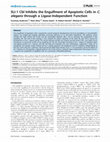
PLOS Genetics, Dec 13, 2012
The engulfment of apoptotic cells is required for normal metazoan development and tissue remodeli... more The engulfment of apoptotic cells is required for normal metazoan development and tissue remodeling. In Caenorhabditis elegans, two parallel and partially redundant conserved pathways act in cell-corpse engulfment. One pathway, which includes the small GTPase CED-10 Rac and the cytoskeletal regulator ABI-1, acts to rearrange the cytoskeleton of the engulfing cell. The CED-10 Rac pathway is also required for proper migration of the distal tip cells (DTCs) during the development of the C. elegans gonad. The second pathway includes the receptor tyrosine kinase CED-1 and might recruit membranes to extend the surface of the engulfing cell. Cbl, the mammalian homolog of the C. elegans E3 ubiquitin ligase and adaptor protein SLI-1, interacts with Rac and Abi2 and modulates the actin cytoskeleton, suggesting it might act in engulfment. Our genetic studies indicate that SLI-1 inhibits apoptotic cell engulfment and DTC migration independently of the CED-10 Rac and CED-1 pathways. We found that the RING finger domain of SLI-1 is not essential to rescue the effects of SLI-1 deletion on cell migration, suggesting that its role in this process is ubiquitin ligase-independent. We propose that SLI-1 opposes the engulfment of apoptotic cells via a previously unidentified pathway.

PLOS Biology, Apr 28, 2009
The engulfment of apoptotic cells is required for normal metazoan development and tissue remodeli... more The engulfment of apoptotic cells is required for normal metazoan development and tissue remodeling. In Caenorhabditis elegans, two parallel and partially redundant conserved pathways act in cell-corpse engulfment. One pathway includes the adaptor protein CED-2 CrkII and the small GTPase CED-10 Rac, and acts to rearrange the cytoskeleton of the engulfing cell. The other pathway includes the receptor tyrosine kinase CED-1 and might recruit membranes to extend the surface of the engulfing cell. Although many components required for engulfment have been identified, little is known about inhibition of engulfment. The tyrosine kinase Abl regulates the actin cytoskeleton in mammals and Drosophila in multiple ways. For example, Abl inhibits cell migration via phosphorylation of CrkII. We tested whether ABL-1, the C. elegans ortholog of Abl, inhibits the CED-2 CrkII-dependent engulfment of apoptotic cells. Our genetic studies indicate that ABL-1 inhibits apoptotic cell engulfment, but not through CED-2 CrkII, and instead acts in parallel to the two known engulfment pathways. The CED-10 Rac pathway is also required for proper migration of the distal tip cells (DTCs) during the development of the C. elegans gonad. The loss of ABL-1 function partially restores normal DTC migration in the CED-10 Rac pathway mutants. We found that ABI-1 the C. elegans homolog of mammalian Abi (Abl interactor) proteins, is required for engulfment of apoptotic cells and proper DTC migration. Like Abl, Abi proteins are cytoskeletal regulators. ABI-1 acts in parallel to the two known engulfment pathways, likely downstream of ABL-1. ABL-1 and ABI-1 interact physically in vitro. We propose that ABL-1 opposes the engulfment of apoptotic cells by inhibiting ABI-1 via a pathway that is distinct from the two known engulfment pathways.
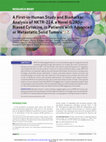
Cancer Discovery, Jun 1, 2019
NKTR-214 (bempegaldesleukin) is a novel IL2 pathway agonist, designed to provide sustained signal... more NKTR-214 (bempegaldesleukin) is a novel IL2 pathway agonist, designed to provide sustained signaling through heterodimeric IL2 receptor βγ to drive increased proliferation and activation of CD8 + T and natural killer cells without unwanted expansion of T regulatory cells (Treg) in the tumor microenvironment. In this fi rst-in-human multicenter phase I study, NKTR-214 administered as an outpatient regimen was well tolerated and showed clinical activity including tumor shrinkage and durable disease stabilization in heavily pretreated patients. Immune activation and increased numbers of immune cells were observed in the periphery across all doses and cycles with no loss of NKTR-214 activity with repeated administration. On-treatment tumor biopsies demonstrated that NKTR-214 promoted immune cell increase with limited increase of Tregs. Transcriptional analysis of tumor biopsies showed that NKTR-214 engaged the IL2 receptor pathway and signifi cantly increased genes associated with an effector phenotype. Based on safety and pharmacodynamic markers, the recommended phase II dose was determined to be 0.006 mg/kg every three weeks. We believe that IL2-and IL2 pathway-targeted agents such as NKTR-214 are key components to an optimal immunotherapy treatment algorithm. Based on its biological activity and tolerability, NKTR-214 is being studied with approved immuno-oncology agents including checkpoint inhibitors.
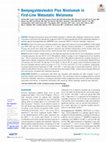
Journal of Clinical Oncology, Sep 10, 2021
PURPOSE Therapies that produce deep and durable responses in patients with metastatic melanoma ar... more PURPOSE Therapies that produce deep and durable responses in patients with metastatic melanoma are needed. This phase II cohort from the international, single-arm PIVOT-02 study evaluated the CD122-preferential interleukin-2 pathway agonist bempegaldesleukin (BEMPEG) plus nivolumab (NIVO) in first-line metastatic melanoma. METHODS A total of 41 previously untreated patients with stage III/IV melanoma received BEMPEG 0.006 mg/kg plus NIVO 360 mg once every 3 weeks for # 2 years; 38 were efficacy-evaluable ($ 1 postbaseline scan). Primary end points were safety and objective response rate (blinded independent central review); other end points included progression-free survival, overall survival (OS), and exploratory biomarkers. RESULTS At 29.0 months' median follow-up, the objective response rate was 52.6% (20 of 38 patients), and the complete response rate was 34.2% (13 of 38 patients). Median change in size of target lesions from baseline was 278.5% (response-evaluable population); 47.4% (18 of 38 patients) experienced complete clearance of target lesions. Median progression-free survival was 30.9 months (95% CI, 5.3 to not estimable). Median OS was not reached; the 24-month OS rate was 77.0% (95% CI, 60.4 to 87.3). Grade 3 and 4 treatment-related and immune-mediated adverse events occurred in 17.1% (7 of 41) and 4.9% (2 of 41) of patients, respectively. Increased polyfunctional responses in CD81 and CD41 T cells were seen in blood after treatment, driven by cytokines with effector functions. Early on-treatment blood biomarkers (CD81 polyfunctional strength difference and eosinophils) correlated with treatment response. CONCLUSION BEMPEG in combination with NIVO was tolerated, with relatively low rates of grade 3 and 4 treatment-related and immune-mediated adverse events. The combination had encouraging antitumor activity in first-line metastatic melanoma, including an extended median progression-free survival. Exploratory analyses associated noninvasive, on-treatment biomarkers with response, before radiologic evidence was observed.
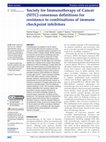
Journal for ImmunoTherapy of Cancer, Mar 1, 2023
Immunotherapy is the standard of care for several cancers and the field continues to advance at a... more Immunotherapy is the standard of care for several cancers and the field continues to advance at a rapid pace, with novel combinations leading to indications in an increasing number of disease settings. Durable responses and long-term survival with immunotherapy have been demonstrated in some patients, though lack of initial benefit and recurrence after extended disease control remain major hurdles for the field. Many new combination regimens are in development for patients whose disease progressed on initial immunotherapy. To guide clinical trial design and support analyses of emerging molecular and cellular data surrounding mechanisms of resistance, the Society for Immunotherapy of Cancer (SITC) previously generated consensus clinical definitions for resistance to single-agent anti-PD-1 immune checkpoint inhibitors (ICIs) in three distinct scenarios: primary resistance, secondary resistance, and progression after treatment discontinuation. An unmet need still exists, however, for definitions of resistance to ICI-based combinations, which represent an expanding frontier in the immunotherapy treatment landscape. In 2021, SITC convened a workshop including stakeholders from academia, industry, and government to develop consensus definitions for resistance to ICI-based combination regimens for improved outcome assessment, trial design and drug development. This manuscript reports the minimum drug exposure requirements and time frame for progression that define resistance in both the metastatic setting and the perioperative setting, as well as key caveats and areas for future research with ICI/ICI combinations. Definitions for resistance to ICIs in combination with chemotherapy and targeted therapy will be published in companion volumes to this paper.
Regular and Young Investigator Award Abstracts, Nov 1, 2022

Journal for ImmunoTherapy of Cancer, Aug 1, 2023
Background The tumor microenvironment (TME) contributes to cancer progression and treatment respo... more Background The tumor microenvironment (TME) contributes to cancer progression and treatment response to therapy, including in renal cell carcinoma (RCC). Prior profiling studies, including single-cell transcriptomics, often involve limited sample sizes and lack spatial orientation. The TME of RCC brain metastases, a major cause of morbidity, also remains largely uncharacterized. Methods We performed digital spatial profiling on the NanoString GeoMx platform using 52 validated immunooncology markers on RCC tissue microarrays representing progressive stages of RCC, including brain metastases. We profiled 76 primary tumors, 27 adjacent histologically normal kidney samples, and 86 metastases, including 24 brain metastases. Results We observed lower immune checkpoint (TIM-3 and CTLA-4), cytolytic (GZMA and GZMB), and T cell activation (CD25) protein expression in metastases compared with primary tumors in two separate cohorts. We also identified changes in macrophages in metastases, with brain metastases-susceptible patients showing less M1-like, inflammatory macrophage markers (HLA-DR and CD127) in metastatic samples. A comparison of brain metastases to extracranial metastases revealed higher expression of the anti-apoptotic, BCL-2-family protein BCL-XL and lower expression of the innate immune activator STING in brain metastases. Lower TIM-3 and CD40 in the TME of brain metastases appear to be associated with longer survival, a finding that requires further validation. Conclusions Compared with primary tumors, RCC metastases, including brain metastases, express lower levels of numerous markers of immune activation and current or investigational therapeutic targets. Our findings may have important implications for designing future biomarker and treatment studies and may aid in development of brain metastases-specific therapies. ⇒ Our findings provide the justification for investigating the therapeutic potential of targeted interventions in RCC, such as BCL-XL inhibitors and STING agonists for brain metastases. Our results could also have important implications for patient selection in future biomarker-driven treatments and clinical trials by suggesting that single-point assessments of the immune microenvironment of primary tumors and brain metastases are not sufficiently informative for clinical decision-making.
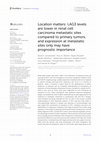
Frontiers in Oncology
While great strides have been made in the treatment of advanced renal cell carcinoma (RCC) with t... more While great strides have been made in the treatment of advanced renal cell carcinoma (RCC) with the emergence of immune checkpoint inhibitors (ICIs) and VEGFR-targeting drugs, sizable proportions of patients still do not respond to upfront therapy and long-term responses only occur in a minority of patients. There is therefore a great need for the development of better predictors of response and an increased understanding of mechanisms of resistance to these therapies. Alternative immune checkpoints outside the PD-1/PD-L1 axis, such as LAG3, have been implicated as one mechanism of resistance to ICIs. These checkpoints thus represent attractive therapeutic targets, and indeed the LAG3 inhibitor relatlimab was recently approved for the treatment of metastatic melanoma in combination with anti-PD-1 therapy. LAG3 inhibitors are being evaluated for RCC as well. In this context, a better understanding of LAG3 expression patterns in RCC and how they relate to clinicopathologic features of...

Journal of Translational Medicine, Aug 16, 2022
Background: The IO Score is a 27-gene immuno-oncology (IO) classifier that has previously predict... more Background: The IO Score is a 27-gene immuno-oncology (IO) classifier that has previously predicted benefit to immune checkpoint inhibitor (ICI) therapy in triple negative breast cancer (TNBC) and non-small cell lung cancer (NSCLC). It generates both a continuous score and a binary result using a defined threshold that is conserved between breast and lung. Herein, we aimed to evaluate the IO Score's binary threshold in ICI-naïve TCGA bladder cancer patients (TCGA-BLCA) and assess its clinical utility in metastatic urothelial cancer (mUC) using the IMvigor210 clinical trial treated with the ICI, atezolizumab. Methods: We identified a list of tumor immune microenvironment (TIME) related genes expressed across the TCGA breast, lung squamous and lung adenocarcinoma cohorts (TCGA-BRCA, TCGA-LUSQ, and TCGA-LUAD, 939 genes total) and then examined the expression of these 939 genes in TCGA-BLCA, to identify patients as having high inflammatory gene expression. Using this as a test of classification, we assessed the previously established threshold of IO Score. We then evaluated the IO Score with this threshold in the IMvigor210 cohort for its association with overall survival (OS). Results: In TCGA-BLCA, IO Score positive patients had a strong concordance with high inflammatory gene expression (p < 0.0001). Given this concordance, we applied the IO Score to the ICI treated IMvigor210 patients. IO Score positive patients (40%) had a significant Cox proportional hazard ratio (HR) of 0.59 (95% CI 0.45-0.78 p < 0.001) for OS and improved median OS (15.6 versus 7.5 months) compared to IO Score negative patients. The IO Score remained significant in bivariate models combined with all other clinical factors and biomarkers, including PD-L1 protein expression and tumor mutational burden. Conclusion: The IMvigor210 results demonstrate the potential for the IO Score as a clinically useful biomarker in mUC. As this is the third tumor type assessed using the same algorithm and threshold, the IO Score may be a promising candidate as a tissue agnostic marker of ICI clinical benefit. The concordance between IO Score and inflammatory gene expression suggests that the classifier is capturing common features of the TIME across cancer types.

Journal of Clinical Oncology, 2016
439 Background: The male predilection of urothelial bladder cancer (UBC) as well as the expressio... more 439 Background: The male predilection of urothelial bladder cancer (UBC) as well as the expression of the androgen receptor in bladder tissue point to the role for androgens in UBC tumorigenesis. Animal studies demonstrate a potential role for androgen deprivation in diminishing UBC. More recently, two separate groups demonstrated decreased rates of both primary and recurrent UBC in prostate cancer patients previously receiving androgen deprivation therapy (ADT). Given the common use of radiation therapy (RT) in the treatment of localized prostate cancer, and previous data supporting the increased frequency of UBC in prostate cancer patients treated with RT, the interaction between ADT and RT in UBC remains an important consideration. Methods: Using the linked SEER-Medicare database, we investigated the interactions among ADT, RT and UBC by performing a retrospective cohort study of elderly (age 66-99) prostate cancer patients diagnosed between 1999-2011. Kaplan-Meier analysis and C...

Journal of Clinical Oncology, 2016
295 Background: The bone seeking calcium mimetic, Radium223 (Ra223), emits high energy alpha part... more 295 Background: The bone seeking calcium mimetic, Radium223 (Ra223), emits high energy alpha particle that cause irreparable double strand DNA breaks in osseous metastases. Ra223 improves survival in patients with bone-predominant metastatic castration resistant prostate cancer (mCRPC). The effect of Ra223 on the host immune system, and T cell immunity in particular, is unknown. Methods: Eligible patients include men with mCRPC, osseous metastases and a clinical indication for Ra223 were eligible. Blood samples were collected at the following time points: prior to the first, second, and fourth treatments (tx) and 4 weeks after the sixth dose. Peripheral blood mononuclear cells (PBMCs) were purified and stained with a cocktail of antibodies to surface and effector immune molecules. Some PBMCs were stimulated and stained for intracellular cytokines (IFN-g, TNF-a, IL-13, IL-17, and IL-21). Stained cells were analyzed by flow cytometry. Results: A total seven patients completed at least...
Journal of the National Comprehensive Cancer Network, 2019
The NCCN Guidelines for Prostate Cancer include recommendations regarding diagnosis, risk stratif... more The NCCN Guidelines for Prostate Cancer include recommendations regarding diagnosis, risk stratification and workup, treatment options for localized disease, and management of recurrent and advanced disease for clinicians who treat patients with prostate cancer. The portions of the guidelines included herein focus on the roles of germline and somatic genetic testing, risk stratification with nomograms and tumor multigene molecular testing, androgen deprivation therapy, secondary hormonal therapy, chemotherapy, and immunotherapy in patients with prostate cancer.

Background The IO Score is a 27-gene immuno-oncology (IO) classifier that has previously predicte... more Background The IO Score is a 27-gene immuno-oncology (IO) classifier that has previously predicted benefit to immune checkpoint inhibitor (ICI) therapy in triple negative breast cancer (TNBC) and non-small cell lung cancer (NSCLC). It generates both a continuous score and a binary result using a defined threshold that is conserved between breast and lung. Herein, we aimed to evaluate the IO Score’s binary threshold in ICI-naïve TCGA bladder cancer patients (TCGA-BLCA) and assess its clinical utility in metastatic urothelial cancer (mUC) using the IMvigor 210 clinical trial treated with the ICI, atezolizumab. Methods We identified a list of tumor immune microenvironment (TIME) related genes expressed across the TCGA breast, lung squamous and lung adenocarcinoma cohorts (TCGA-BRCA, TCGA-LUSQ, and TCGA-LUAD, 939 genes total) and then examined the expression of these 939 genes in TCGA-BLCA, to identify patients as having high inflammatory gene expression. Using this as a test of classif...

Journal of Clinical Oncology
288 Background: Nivolumab (nivo) is FDA approved for patients (pts) with VEGFR TKI-resistant RCC ... more 288 Background: Nivolumab (nivo) is FDA approved for patients (pts) with VEGFR TKI-resistant RCC and the nivo + ipilimumab (nivo/ipi) combination is FDA approved for treatment naïve pts with IMDC intermediate and poor risk renal cell carcinoma (RCC). Little information was available on the efficacy and toxicity of nivo monotherapy in treatment naïve RCC or the efficacy of nivo/ipi salvage in pts with tumors resistant to initial nivo monotherapy. Methods: Eligible pts with treatment naïve RCC received nivo 240mg IV q2 wk x 6 doses followed by 360mg IV q3 wk x 4 doses followed by 480 mg q4 wk until progressive disease (PD), toxicity, or completion of 96 wks of treatment (Part A). Pts with PD prior to, or stable disease (SD) at 48 wks (pSD) were potentially eligible to receive salvage nivo (3mg/kg)/ipi (1 mg/kg) q3 wk x 4 doses followed by q4 wk nivo maintenance for up to 48 wks (Part B). All pts were required to submit tissue from a metastatic lesion obtained within 12 months (mos) pr...
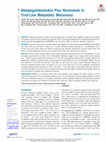
Journal of Clinical Oncology, 2021
PURPOSE Therapies that produce deep and durable responses in patients with metastatic melanoma ar... more PURPOSE Therapies that produce deep and durable responses in patients with metastatic melanoma are needed. This phase II cohort from the international, single-arm PIVOT-02 study evaluated the CD122-preferential interleukin-2 pathway agonist bempegaldesleukin (BEMPEG) plus nivolumab (NIVO) in first-line metastatic melanoma. METHODS A total of 41 previously untreated patients with stage III/IV melanoma received BEMPEG 0.006 mg/kg plus NIVO 360 mg once every 3 weeks for ≤ 2 years; 38 were efficacy-evaluable (≥ 1 postbaseline scan). Primary end points were safety and objective response rate (blinded independent central review); other end points included progression-free survival, overall survival (OS), and exploratory biomarkers. RESULTS At 29.0 months' median follow-up, the objective response rate was 52.6% (20 of 38 patients), and the complete response rate was 34.2% (13 of 38 patients). Median change in size of target lesions from baseline was −78.5% (response-evaluable populatio...










Uploads
Papers by Michael Hurwitz